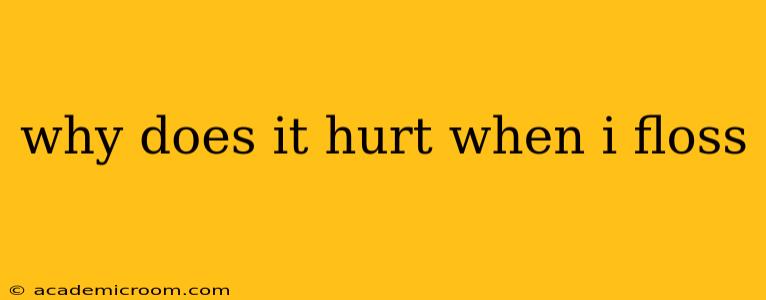Flossing is crucial for maintaining good oral hygiene, yet many people avoid it because it hurts. Pain during flossing usually indicates a problem, but it doesn't mean you should give up. This guide will explore the common causes of flossing pain and offer solutions to make the process more comfortable and effective.
Why Does Flossing Hurt?
The pain you experience when flossing can stem from several factors, ranging from simple irritation to more serious dental issues. Let's break down the most common culprits:
1. Gum Inflammation (Gingivitis):
This is the most frequent reason for flossing pain. Gingivitis is an early stage of gum disease characterized by inflamed, red, and often bleeding gums. When you floss, you're essentially irritating already sensitive gum tissue, leading to discomfort. Regular flossing is actually crucial for preventing and treating gingivitis, even if it initially causes some pain. As your gums heal, the discomfort should lessen.
2. Plaque Buildup:
Plaque is a sticky film of bacteria that constantly forms on your teeth. If you haven't flossed regularly, plaque can build up, hardening into tartar (calculus). This buildup irritates the gums and makes flossing painful. The scraping sensation you feel when flossing against plaque is a sign that it needs to be removed.
3. Improper Flossing Technique:
Using the wrong technique can cause pain and even damage your gums. Snapping the floss between your teeth or forcing it too aggressively can injure the gum tissue. Learning the proper technique is paramount to comfortable and effective flossing.
4. Receding Gums:
Receding gums expose the roots of your teeth, which are more sensitive than the enamel-covered crown. Flossing can irritate these exposed root surfaces, causing pain. This is often a sign of more advanced gum disease and requires professional dental attention.
5. Newly Filled or Extracted Teeth:
After dental work, the area around the tooth might be sensitive and painful for a while. Flossing in this area may cause discomfort until the area heals. Gentle flossing around these areas is usually recommended, but always follow your dentist's specific instructions.
6. Braces or Other Orthodontic Appliances:
Braces and other orthodontic devices can make flossing more challenging and potentially painful. Specialized floss threaders and interdental brushes can help you reach those hard-to-clean areas more comfortably.
How to Make Flossing Less Painful
Here are some tips to ease the discomfort and make flossing a less daunting task:
- Use the Right Floss: Experiment with different types of floss, such as waxed or unwaxed, to find what works best for you. Some people find that waxed floss glides more easily between teeth.
- Gentle Technique: Avoid snapping the floss between your teeth. Gently guide the floss between your teeth using a curved C-shape around each tooth.
- Start Slowly: If you're experiencing significant pain, begin by flossing just a few teeth each day and gradually increase the number as your gums become less sensitive.
- Frequent, Gentle Flossing: Regular, gentle flossing is key. It's better to floss daily with a gentle approach than to floss aggressively once a week.
- Consult Your Dentist: If the pain persists or is severe, schedule an appointment with your dentist to rule out any underlying dental issues. They can assess your gums, identify potential problems, and offer personalized advice.
What if Flossing Still Hurts After Trying These Tips?
If you've tried these suggestions and still experience significant pain while flossing, it's essential to consult your dentist. Persistent pain during flossing could be a sign of a more serious condition, such as gum disease or other dental problems. Your dentist can provide a proper diagnosis and recommend the best course of action. Don't let flossing pain deter you from maintaining optimal oral health. With the right techniques and professional guidance, you can floss comfortably and keep your smile healthy and bright.
